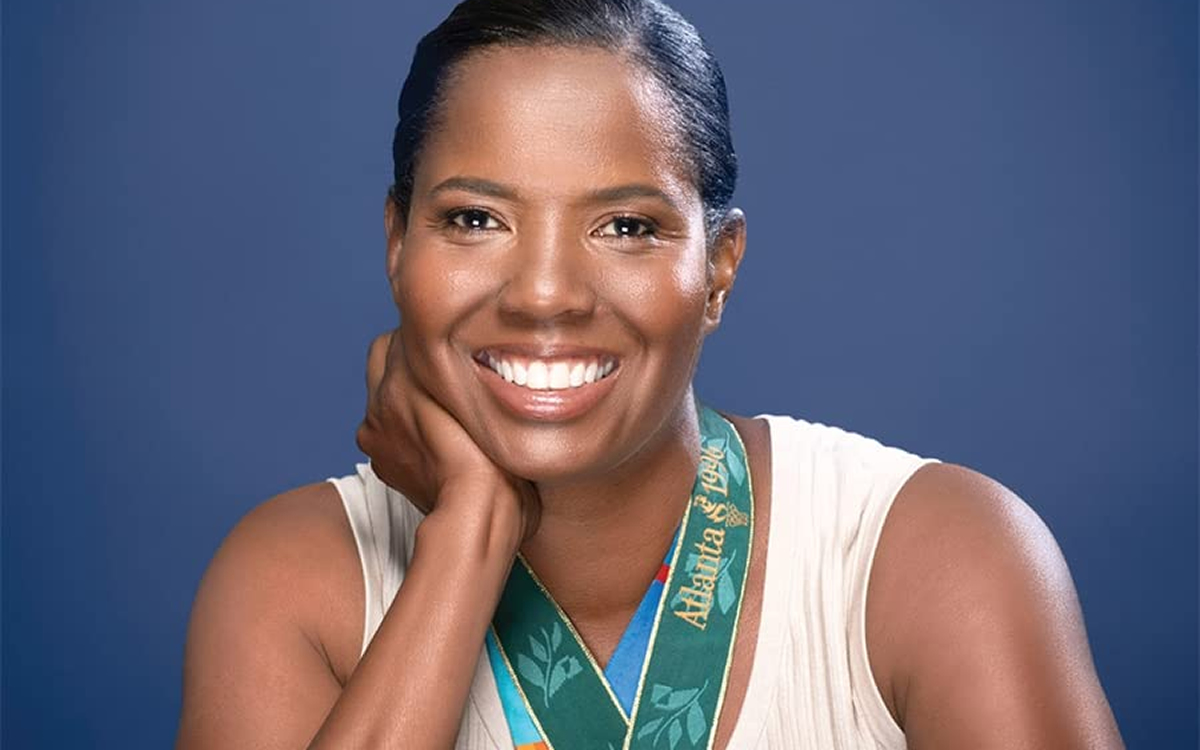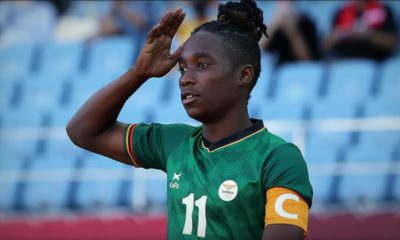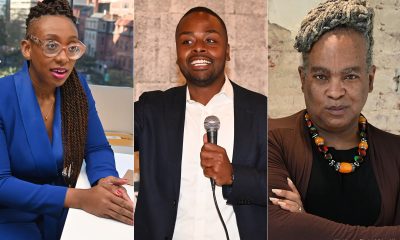Books
Trailblazing soccer legend Briana Scurry inspires with new book
‘My Greatest Save’ recounts highs and lows of her remarkable life

Black lesbian soccer icon Briana Scurry knew from the get-go that she would compete in the Olympics.
In February 1980, Scurry, then eight, was in the family room in her home in Dayton, Minn., watching the Winter Olympics, held that year in Lake Placid, N.Y. The United States was playing hockey against Russia. In what became known as “the Miracle on Ice,” the U.S. Olympic team won the gold medal.
Scurry cheered for the U.S. team. But Jim Craig, the team’s goaltender, especially, became a hero for her. “One day I am going to be an Olympian, too,” Scurry decided.
This sounds like a child’s daydream – with as much chance of becoming a reality as a happily-ever-after-Disney movie.
But trailblazing soccer legend Briana Scurry has proved that, with talent, hard work, support from family and friends, along with a sense of humor, dreams can come true.
The child who dreamed of being an Olympian grew up to find herself on the Wheaties box for her winning save as goalkeeper for the U.S. Women’s National Soccer Team in the 1999 FIFA World Cup championship game. (FIFA is world soccer’s governing body.)
“I believe I’m the only Black lesbian to be on a Wheaties box,” Scurry, who won the gold medal in the 1996 and 2004 Summer Olympics, said in a recent interview with the Blade.
Scurry’s life has had Olympian highs and hellish lows.
In 2010, her soccer career ended after she sustained a traumatic brain injury during a game. Scurry ran up against an insurance company that wouldn’t pay for the medical care she needed.
At one of her lowest points, she had to pawn her Olympic gold medals to pay for food.
In “My Greatest Save: The Brave, Barrier-Breaking Journey of a World-Champion Goalkeeper,” her revealing, moving, can’t-put-down book, (written with Wayne Coffey), coming out on June 21, Scurry tells her compelling story.
It is “more than the story of an all-time great goalkeeper,” tennis legend and LGBTQ icon Billie Jean King said of “My Greatest Save.” “It’s about a pioneering female athlete who made sure to honor those who came before her even as she worked hard to make things better for those who came after her.”
“It was time,” Scurry said when asked why she wrote the book, “I was in a good place to do it.”
When you’re in a tough situation it’s hard to see how to write about it, she added, “I had to go away from it to go back to it. We started in 2020 right before the pandemic.”
Scurry hopes the book will inspire readers. “I hope it will encourage people to blaze trails in their own lives,” she said.
Scurry wanted readers to see behind the veil of a professional athlete – to see how she overcame obstacles, kept going, and reached her goals.
Throughout her life and career, Scurry has encountered obstacles and barriers from a traumatic brain injury to racism and homophobia.
From early on, Scurry was aware that she was different. There were few people of color when she was in elementary, middle, or high school. The youth soccer teams that she played on were also predominantly white. During her 17 years with the U.S. Women’s Soccer National Team, “it was the same thing — at least among the core players,” she writes in “My Greatest Save.”
In 2017, Scurry became the first Black woman to be elected to the National Soccer Hall of Fame, and she is one of the first out LGBTQ soccer players.
Scurry was so supportive of other queer soccer players that she became known as the “welcome wagon.”
“When I played with the Atlanta Beat we’d compete fearlessly against the opposing team,” Scurry said. “But after the game, [the Atlanta and the opposing team] wanted to hang out.”
Scurry would take the LGBTQ home and opposing players to a fun, safe place — a bar where they could grab something to eat and dance. “Then we’d go back to competing ferociously in the next game,” she said.
Scurry thinks she has been discriminated against because of how she looks. “Because I’m Black and lesbian,” she said.
In 1999, after the World Cup win, Scurry kissed her then girlfriend. “When we kissed the TV cameras cut away because we were lesbians.”
She also believes that she’s received fewer offers for commercial endorsements than white, heterosexual athletes.
Scurry worries about the “Don’t Say Gay” and anti-trans laws that are being passed nationwide. “I worry that these [queer] kids will be bullied. That they might become suicidal,” she said.
“I wrote my book for LGBTQ kids,” Scurry said, “I want them to believe in themselves and to believe that they can be athletes.”
“We’re going backwards,” Scurry added. “It’s frustrating. It’s tiring but we’re going to have to keep fighting for our rights.”
Scurry was forced to engage in one of the toughest fights of her life after she had a traumatic brain injury while playing soccer in 2010. After she was injured, Scurry was labeled “temporarily totally disabled.” That label was a severe understatement.
Scurry’s head injury left her in unbearable pain. It was incredibly hard for her to concentrate on the simplest things — from reading more than a couple of paragraphs to following the plot of a TV show.
Scurry became so depressed that she came close to ending her life. (If you are having suicidal thoughts, contact the Trevor Project and/or the National Suicide Prevention Lifeline).
“The insurance company said I was faking it,” Scurry said. “I told them I was a professional athlete. There was nothing I wanted more in the world than to get back in the game.”
“Why in the world would I have wanted to fake not being able to work?” she said.
Thankfully, in this low period in her life, Scurry was connected, through friends to Chryssa Zizos, who works in public relations.
Zizos publicized Scurry’s struggle with the insurance company. The publicity was effective. The company agreed to pay for the physical therapy and surgery that Scurry needed.
Today, Scurry and Zizos are happily married. Scurry loves being step-mom to Zizos’s children, who call her “bonus mom.”
Scurry, now fully recovered, talks about her traumatic brain injury to educate soccer players, coaches, and parents about concussions.
“There’s more research now about ways to help protect players from concussions,” she said.
Headbands would help protect players against concussions, Scurry said. “Some of the players won’t wear headbands,” she added, “because it would be perceived as weakness.”
Shin guards used to be voluntary, and players didn’t wear them, Scurry said.
“But after FIFA mandated them, players wore them,” she said. “The same thing would happen if FIFA mandated headbands.”
Scurry was thrilled last month when news broke from The New York Times and other outlets that landmark contracts had been signed with the U.S. Soccer Federation. The contracts say that, for the first time, men and women soccer teams will be paid equally in international matches and competitions. The agreement says that in forthcoming World Cup tournaments men and women will be paid equally in money awarded by FIFA in prizes.
“I’m overjoyed about women getting equal pay,” Scurry said.
Fifty years ago this month, Title IX of the Education Amendments of 1972 became law. The legislation, which prohibits discrimination against women in education, has enabled thousands of women and girls to participate in sports in high schools, colleges and professionally.
“Title IX opened the door for millions of girls around the country to be able to participate in sports,” Scurry said.
“Without Title IX … there would have been no path for me to play soccer collegiately and professionally,” she added.
The Blade may receive commissions from qualifying purchases made via this post.
Books
‘Dogs of Venice’ looks at love lost and rediscovered
A solo holiday trip to Italy takes unexpected turn

‘The Dogs of Venice’
By Steven Crowley
c.2025, G.P. Putnam & Sons
$20/65 pages
One person.
Two, 12, 20, you can still feel alone in a crowded room if it’s a place you don’t want to be. People say, though, that that’s no way to do the holidays; you’re supposed to Make Merry, even when your heart’s not in it. You’re supposed to feel happy, no matter what – even when, as in “The Dogs of Venice” by Steven Rowley, the Christmas tinsel seems tarnished.

Right up until the plane door closed, Paul held hope that Darren would decide to come on the vacation they’d planned for and saved for, for months.
Alas, Darren was a no-show, which was not really a surprise. Three weeks before the departure, he’d announced that their marriage wasn’t working for him anymore, and that he wanted a divorce. Paul had said he was going on the vacation anyhow. Why waste a perfectly good flight, or an already-booked B&B? He was going to Venice.
Darren just rolled his eyes.
Was that a metaphor for their entire marriage? Darren had always accused Paul of wanting too much. He indicated now that he felt stifled. Still, Darren’s unhappiness hit Paul broadside and so there was Paul, alone in a romantic Italian city, fighting with an espresso machine in a loft owned by someone who looked like a frozen-food spokeswoman.
He couldn’t speak or understand Italian very well. He didn’t know his way around, and he got lost often. But he felt anchored by a dog.
The dog – he liked to call it his dog – was a random stray, like so many others wandering around Venice unleashed, but this dog’s confidence and insouciant manner inspired Paul. If a dog could be like that, well, why couldn’t he?
He knew he wasn’t unlovable but solo holidays stunk and he hated his situation. Maybe the dog had a lesson to teach him: could you live a wonderful life without someone to watch out for, pet, and care for you?
Pick up “The Dogs of Venice,” and you might think to yourself that it won’t take long to read. At under 100 pages, you’d be right – which just gives you time to turn around and read it again. Because you’ll want to.
In the same way that you poke your tongue at a sore tooth, author Steven Rowley makes you want to remember what it’s like to be the victim of a dead romance. You can do it here safely because you simply know that Paul is too nice for it to last too long. No spoilers, though, except to say that this novel is about love – gone, resurrected, misdirected – and it unfolds in exactly the way you hope it will. All in a neat evening’s worth of reading. Perfect.
One thing to note: the Christmas setting is incidental and could just as well be any season, which means that this book is timely, no matter when you want it. So grab “The Dogs of Venice,” enjoy it twice with your book group, with your love, or read it alone.
The Blade may receive commissions from qualifying purchases made via this post.

Santa will be very relieved.
You’ve taken most of the burden off him by making a list and checking it twice on his behalf. The gift-buying in your house is almost done – except for those few people who are just so darn hard to buy for. So what do you give to the person who has (almost) everything? You give them a good book, like maybe one of these.
Memoir and biography
The person who loves digging into a multi-level memoir will be happy unwrapping “Blessings and Disasters: A Story of Alabama” by Alexis Okeowo (Henry Holt). It’s a memoir about growing up Black in what was once practically ground zero for the Confederacy. It’s about inequality, it busts stereotypes, and yet it still oozes love of place. You can’t go wrong if you wrap it up with “Queen Mother: Black Nationalism, Reparations, and the Untold Story of Audley Moore” by Ashley D. Farmer (Pantheon). It’s a chunky book with a memoir with meaning and plenty of thought.
For the giftee on your list who loves to laugh, wrap up “In My Remaining Years” by Jean Grae (Flatiron Books). It’s part memoir, part comedy, a look back at the late-last-century, part how-did-you-get-to-middle-age-already? and all fun. Wrap it up with “Here We Go: Lessons for Living Fearlessly from Two Traveling Nanas” by Eleanor Hamby and Dr. Sandra Hazellip with Elisa Petrini (Viking). It’s about the adventures of two 80-something best friends who seize life by the horns – something your giftee should do, too.
If there’ll be someone at your holiday table who’s finally coming home this year, wrap up “How I Found Myself in the Midwest” by Steve Grove (Simon & Schuster). It’s the story of a Silicon Valley worker who gives up his job and moves with his family to Minnesota, which was once home to him. That was around the time the pandemic hit, George Floyd was murdered, and life in general had been thrown into chaos. How does someone reconcile what was with what is now? Pair it with “Homestand: Small Town Baseball and the Fight for the Soul of America” by Will Bardenwerper (Doubleday). It’s set in New York and but isn’t that small-town feel universal, no matter where it comes from?
Won’t the adventurer on your list be happy when they unwrap “I Live Underwater” by Max Gene Nohl (University of Wisconsin Press)? They will, when they realize that this book is by a former deep-sea diver, treasure hunter, and all-around daredevil who changed the way we look for things under water. Nohl died more than 60 years ago, but his never-before-published memoir is fresh and relevant and will be a fun read for the right person.
If celeb bios are your giftee’s thing, then look for “The Luckiest” by Kelly Cervantes (BenBella Books). It’s the Midwest-to-New-York-City story of an actress and her life, her marriage, and what she did when tragedy hit. Filled with grace, it’s a winner.
Your music lover won’t want to open any other gifts if you give “Only God Can Judge Me: The Many Lives of Tupac Shakur” by Jeff Pearlman (Mariner Books). It’s the story of the life, death, and everything in-between about this iconic performer, including the mythology that he left behind. Has it been three decades since Tupac died? It has, but your music lover never forgets. Wrap it up with “Point Blank (Quick Studies)” by Bob Dylan, text by Eddie Gorodetsky, Lucy Sante, and Jackie Hamilton (Simon & Schuster), a book of Dylan’s drawings and artwork. This is a very nice coffee-table size book that will be absolutely perfect for fans of the great singer and for folks who love art.
For the giftee who’s concerned with their fellow man, “The Lost and the Found: A True Story of Homelessness, Found Family and Second Chances” by Kevin Fagan (One Signal / Atria) may be the book to give. It’s a story of two “unhoused” people in San Francisco, one of the country’s wealthiest cities, and their struggles. There’s hope in this book, but also trouble and your giftee will love it.
For the person on your list who suffered loss this year, give “Pine Melody” by Stacey Meadows (Independently Published), a memoir of loss, grief, and healing while remembering the person gone.
LGBTQ fiction
For the mystery lover who wants something different, try “Crime Ink: Iconic,” edited by John Copenhaver and Salem West (Bywater Books), a collection of short stories inspired by “queer legends” and allies you know. Psychological thrillers, creepy crime, cozies, they’re here.
Novel lovers will want to curl up this winter with “Middle Spoon” by Alejandro Varela (Viking), a book about a man who appears to have it all, until his heart is broken and the fix for it is one he doesn’t quite understand and neither does anyone he loves.
LGBTQ studies – nonfiction
For the young man who’s struggling with issues of gender, “Before They Were Men” by Jacob Tobia (Harmony Books) might be a good gift this year. These essays on manhood in today’s world works to widen our conversations on the role politics and feminism play in understanding masculinity and how it’s time we open our minds.
If there’s someone on your gift list who had a tough growing-up (didn’t we all?), then wrap up “I’m Prancing as Fast as I Can” by Jon Kinnally (Permuted Press / Simon & Schuster). Kinnally was once an awkward kid but he grew up to be a writer for TV shows you’ll recognize. You can’t go wrong gifting a story like that. Better idea: wrap it up with “So Gay for You: Friendship, Found Family, & The Show That Started It All” by Leisha Hailey & Kate Moennig (St. Martin’s Press), a book about a little TV show that launched a BFF-ship.
Who doesn’t have a giftee who loves music? You sure do, so wrap up “The Secret Public: How Music Moved Queer Culture from the Margins to the Mainstream” by Jon Savage (Liveright). Nobody has to tell your giftee that queer folk left their mark on music, but they’ll love reading the stories in this book and knowing what they didn’t know.
The Blade may receive commissions from qualifying purchases made via this post.
Books
‘90s club kids will love Mark Ronson’s new book
‘Night People’ part esoteric hip-hop discography, part biography

‘Night People’
By Mark Ronson
c.2025, Grand Central
$29/256 pages
You just can’t hold still.
The music starts and your hips shake, your shoulders bounce, your fingers tickle the sky to match a beat. Your air guitar is on-point, your head bops and your toes tap. You can’t help it. As in the new memoir, “Night People” by Mark Ronson, you just gotta dance.

With a mother who swanned around with rock bands, a father who founded a music publishing company, and a stepfather who founded the band, Foreigner, it was natural that Mark Ronson would fall into a music career of some sort. He says he was only 10 years old when he realized the awesome power of music.
As a pre-teen, he liked to mix music in his stepfather’s studio. As a teenager, he formed a band with Sean Lennon that didn’t quite catch on. In the fall of his senior year of high school, Ronson began sneaking into Manhattan clubs to listen to music, dance, and find drugs. It was there that he noticed the alchemy that the DJs created and he searched for someone who’d teach him how to do that, too. He became obsessed.
Finding a gig in a New York club, though, was not easy.
Ronson worked a few semi-regular nights around New York City, and at various private parties to hone his skills. His mother purchased for him the electronic equipment he needed, turntables, and amps. He befriended guys who taught him where to get music demos and what to look for at distributor offices, and he glad-handed other DJs, club owners, and music artists.
That, and the rush he got when the dance floor was packed, made the job glamorous. But sometimes, attendance was low, DJ booths were located in undesirable places, and that totally killed the vibe.
Some people, he says, are mostly day people. For others, though, sunlight is something to be endured. Nighttime is when they when they feel most alive.
Part esoteric hip-hop discography, part biography, part SNL’s Stefan, and part cultural history, “Night People” likely has a narrow audience. If you weren’t deep into clubbing back in the day, you can just stop here. If you were ages 15 to 30, 30 years ago, and you never missed club night then, keep reading. This is your book.
Author Mark Ronson talks the talk, which can be good for anyone who knows the highs of a jam-packed club and the thrill of being recognized for skills with a turntable. That can be fun, but it may also be too detailed: mixology is an extremely heavy subject here. Many of the tunes he names were hits only in the clubs and only briefly, and many of the people he name-drops are long gone. Readers may find themselves not particularly caring. Heavy sigh.
This isn’t a bad book, but it’s absolutely not for everyone. If you weren’t into clubbing, pass and you won’t miss a thing. If you were a die-hard club kid back then, though, “Night People” will make your eyes dance.
Want more? Then check out “What Doesn’t Kill Me Makes Me Weirder and Harder to Relate To” by Mary Lucia (University of Minnesota Press). It’s Lucia’s tale of being a rock DJ in Minneapolis-St. Paul, life with legions of listeners, and not being listened to by authorities for over three harrowing, terrifying years while she was stalked by a deranged fan.
The Blade may receive commissions from qualifying purchases made via this post.
-

 District of Columbia1 day ago
District of Columbia1 day agoReasons to be optimistic about 2026
-

 Commentary3 days ago
Commentary3 days agoAmerica is going in the wrong direction for intersex children
-

 District of Columbia3 days ago
District of Columbia3 days agoRush reopens after renewing suspended liquor license
-

 Real Estate4 days ago
Real Estate4 days agoChild- and pet-proofing your home for the holidays


















